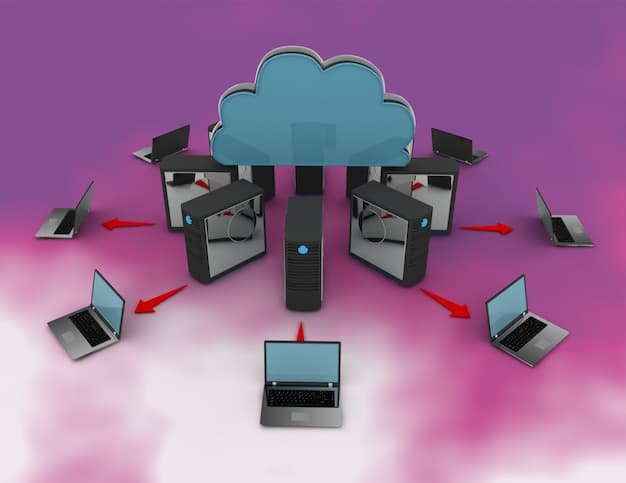Edge Computing: Opportunities for US Businesses in 2025

The rise of edge computing presents significant opportunities for US businesses in 2025, enabling faster data processing, improved security, and enhanced customer experiences closer to the end-users.
As we approach 2025, the rise of edge computing is poised to revolutionize the way US businesses operate. The rise of edge computing: opportunities for US businesses in 2025 will become increasingly significant, unlocking new efficiencies, improving data security, and enhancing customer experiences in ways previously unimaginable.
Understanding Edge Computing
Edge computing is a distributed computing framework that brings computation and data storage closer to the devices where it is being gathered. This proximity minimizes latency and bandwidth usage, making it invaluable for applications requiring real-time processing.
Unlike traditional cloud computing, where data is sent to a centralized server, edge computing enables data to be processed locally at the “edge” of the network—think sensors, mobile devices, or local servers. This shift enhances operational efficiency and responsiveness.
Key Components of Edge Computing
Edge computing involves several critical elements working together to facilitate efficient data processing and analysis.
- Edge Devices: These are the physical devices, such as sensors, smartphones, and IoT devices, that collect data.
- Edge Servers: Located closer to the edge devices, these servers process the data locally, reducing latency.
- Network Infrastructure: The connectivity that allows edge devices and servers to communicate efficiently.
Benefits of Edge Computing
The advantages of edge computing are numerous and appeal to a wide range of industries.
- Reduced Latency: Processing data locally minimizes delays, essential for real-time applications.
- Improved Bandwidth Efficiency: Processing data at the edge reduces the amount of data that needs to be transmitted, saving bandwidth.
- Enhanced Security: Keeping data closer to its source enhances data protection and reduces the risk of interception during transit.
In conclusion, understanding the fundamentals of edge computing sets the stage for appreciating its potential impact on US businesses.
The Competitive Advantages of Edge Computing in 2025
In 2025, adopting edge computing is not just about keeping up with technology trends, it’s about securing significant competitive advantages. The speed, security, and efficiency afforded by edge computing will dramatically reshape industry landscapes.
Businesses that integrate edge computing into their operations will experience enhanced responsiveness, better resource utilization, and stronger data privacy, all of which contribute to a better bottom line.
Real-Time Data Processing
One of the primary advantages of edge computing is its ability to process data in real time. This capability enables quick decision-making and immediate action, essential in fast-paced industries.
Think of autonomous vehicles making split-second decisions, or manufacturers instantly identifying and fixing defects in real-time. These scenarios highlight the transformative impact of real-time data processing.
Enhanced Data Security
Data security is a paramount concern for businesses today. Edge computing offers enhanced security by keeping sensitive data within a local network, minimizing exposure to external threats.
By processing data on-site, businesses reduce the risk of data breaches and comply better with stringent data protection regulations, thereby building trust with their stakeholders.

In summary, edge computing provides competitive advantages by facilitating real-time data processing and improving data security, which are crucial for staying ahead in 2025.
Key Industries Set to Benefit
Several industries stand to gain substantially from the adoption of edge computing in 2025. These sectors, with their unique data processing requirements, are perfectly positioned to leverage the benefits of this technology.
From healthcare to manufacturing, transportation to retail, edge computing is poised to transform operations, enhance efficiency, and drive innovation.
Healthcare
The healthcare industry can significantly benefit from edge computing by enhancing patient care and streamlining operations. Telemedicine and remote patient monitoring, for example, require real-time data processing.
Edge computing enables healthcare providers to analyze patient data instantly, improving diagnostic accuracy and speeding up the response to emergencies. This results in better patient outcomes and more efficient healthcare services.
Manufacturing
In manufacturing, edge computing facilitates predictive maintenance and quality control. Real-time analysis of sensor data helps manufacturers identify potential equipment failures before they occur.
This proactive approach reduces downtime, lowers maintenance costs, and ensures consistent product quality, ultimately boosting productivity and profitability.
Transportation
The transportation industry is being revolutionized by edge computing through applications like smart traffic management and autonomous vehicles. Edge computing allows vehicles to process data from sensors and cameras in real-time.
- Optimizing traffic flow reduces congestion.
- Enhancing safety protocols saves lives.
- Improving logistics leads to fuel efficiency.
In conclusion, healthcare, manufacturing, and transportation are among the key industries poised to reap significant benefits from edge computing’s rapid advancements.
Overcoming Challenges in Edge Computing Adoption
While the benefits of adopting edge computing are clear, businesses must also acknowledge and address the potential challenges. Strategic planning and proactive measures are essential for a successful implementation.
From security concerns to integration complexities, knowing how to navigate these obstacles is critical for realizing the full potential of edge computing.
Security Concerns
Securing edge devices and networks is paramount. The distributed nature of edge computing can create vulnerabilities if not properly managed. Robust security protocols and continuous monitoring are essential to protect devices and data from cyber threats.
Integration Complexities
Integrating edge computing into existing IT infrastructure can be complex. Compatibility issues, data silos, and legacy systems can pose significant challenges.
A phased approach, focusing on interoperability and standardization, can help businesses gradually and effectively integrate edge computing into their current frameworks.

In summary, by understanding and mitigating potential security risks and integration challenges, businesses can pave the way for a seamless and successful transition to edge computing.
Building a Future-Ready Infrastructure
To fully leverage the rise of edge computing, US businesses must focus on building a future-ready infrastructure. This involves not only investing in the right technologies but also developing the necessary skills and expertise within their workforce.
Creating a scalable, secure, and efficient edge computing environment requires both technical upgrades and strategic workforce development.
Investing in Scalable Technologies
Scalability is key to accommodating future growth and evolving business needs. Businesses should invest in edge computing solutions that can easily expand as their data processing requirements increase.
This involves choosing hardware and software solutions that are designed for flexibility and can adapt to changing demands without requiring significant overhauls.
Developing In-House Expertise
Having skilled personnel is essential for managing and optimizing edge computing infrastructure. Businesses should invest in training programs to develop in-house expertise.
- Providing training in data analytics
- Ensuring proficiency in cybersecurity
- Offering courses in network architecture
By focusing on scalability and developing in-house capabilities, US businesses can create robust infrastructures ready to embrace the full potential of edge computing.
Looking Ahead: Edge Computing Trends Beyond 2025
As we look beyond 2025, edge computing is only expected to grow in importance and sophistication. Emerging trends and technological advancements will continue to shape its evolution.
Staying informed about these trends is crucial for businesses that want to remain competitive and innovative in the long term.
Artificial Intelligence at the Edge
Integrating artificial intelligence (AI) with edge computing enables smarter and more autonomous systems. AI-powered edge devices can make real-time decisions without needing to send data to central servers.
This capability is particularly useful in applications like autonomous vehicles, smart cities, and advanced manufacturing, enhancing efficiency and reducing response times.
5G and Edge Computing
The rollout of 5G technology is accelerating the adoption of edge computing. 5G’s high bandwidth and low latency make it an ideal complement to edge computing.
- Enabling faster data transfer between devices.
- Improving the performance of real-time applications.
- Supporting a greater number of connected devices.
In conclusion, the integration of AI and 5G with edge computing marks a transformative era, paving the way for smarter, faster, and more efficient systems in the years ahead.
| Key Point | Brief Description |
|---|---|
| 🚀 Reduced Latency | Processing data locally minimizes delays for real-time response. |
| 🔒 Enhanced Security | Keeping data closer to the source improves data protection. |
| 🏭 Manufacturing Benefits | Predictive maintenance and quality control improve productivity. |
| 🏥 Healthcare Improvements | Real-time analysis enhances patient care and speeds up diagnosis. |
Frequently Asked Questions
Edge computing is a distributed computing paradigm that brings data storage and processing closer to the data source. Unlike traditional cloud infrastructure, it minimizes latency and allows for faster data access and analysis.
Edge computing enhances data security by processing data locally, which reduces the risk of data breaches during transit to centralized servers. This localization helps comply with stringent data regulations effectively.
Industries like healthcare, manufacturing, and transportation benefit greatly from edge computing. Healthcare gains from real-time patient data analysis, while manufacturing improves predictive maintenance and quality control.
Key challenges include ensuring robust security for distributed devices, handling integration issues with existing infrastructure, and building enough expertise to manage and maintain an edge-based ecosystem.
5G enhances edge computing through its higher bandwidth and reduced latency, enabling quicker data transfer, support for more connected devices, and enhanced performance for real-time applications, improving the user experience.
Conclusion
As we conclude, the rise of edge computing presents unparalleled opportunities for US businesses in 2025 and beyond. By embracing this transformative technology, companies can unlock new efficiencies, enhance security, and drive innovation, positioning themselves for long-term success in an increasingly competitive landscape.





